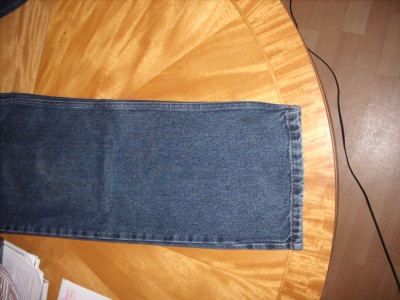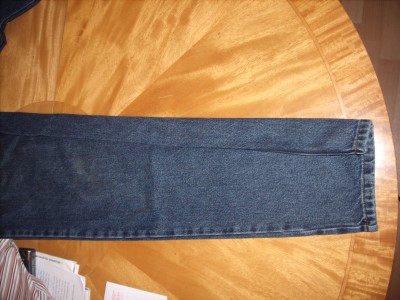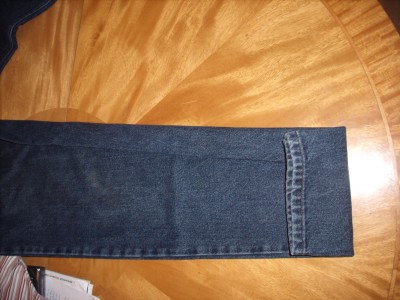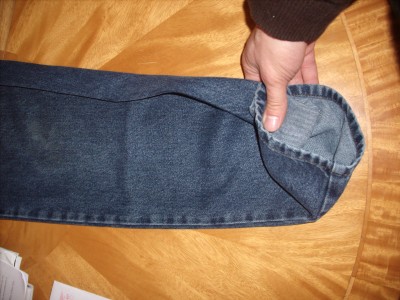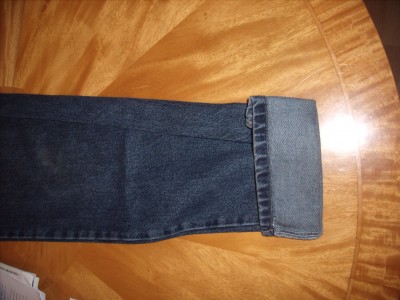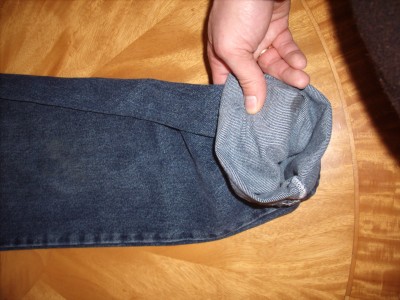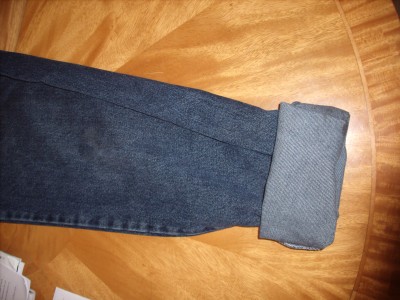Tires; Cool and Dry
February 9th, 2012
There are many kinds of tires; they vary in width, tread, puncture resistance, tubeless or tubed, and accessories. Road racers tend to ride very narrow tires (23 or 25 mm width) and with little to no tread; commuters and bike tourers ride wider tires (28 to 35 mm, sometimes higher) with some tread; mountain bikers ride wide tires (2 inches and up) with moderate to gigantic tread. Almost without exception, in snowy winter road riding, you can get away with a treaded tire, although studs give you the maximum level of safety. I have some 35mm aggressive tread tires which worked wonders last year in the snow, however, they’re useless on trails. I’d love to report on studs, but there’s yet to be any ice or snow worth its salt (har har) this year.
As a transportation biker, the most important thing to me is reliability, which means not having to stop for a flat. I always buy the more expensive tires (around $40 each), which have a Kevlar strip to resist punctures; once the tire tread starts showing little tears and becomes soft (the tire seems to absorb any sand or salt on the road), the its life is almost over. When I’ve gotten a few flats in a short period, then it’s time to replace it. However, the benefit of using these tires is that I get a flat once every six months or so; on my fixed gear bike, I realized recently I haven’t touched the wheels in over a year (granted, it gets less use now that it’s not my commuter).
Despite their reliability, I still carry (and know how to use) a flat fix kit. Most of the time it just takes up space at the bottom of my bag.
Weather
It was a very easy day of riding. I was wearing a suit today (and the weather isn’t crummy!) so I took the commuter, which was an unwelcome change, although I fixed the shifting and cleaned the chain, so it was a very smooth ride.
Temperature: 33 degrees
Road condition: Dry
Clothing: Heavy winter coat, rain pants (gotta keep those suit pants clean), Timberland shoes. I had the suit jacket in my panniers, if you’re wondering.
Comfort: It was noticeably warmer on the ride, and I had to go slow up the Longfellow Bridge to stay cool.
Whoa, Bikers! Cold and Dry
February 8th, 2012
I’m going to switch up the post order, putting weather and such at the end now. It’s been pretty repetitive, so I’ll put the variety up front.
If your knees (as opposed to thighs or calves) hurt from pedaling, your chain needs maintenance. If the bike is painfully unresponsive to your pedaling, your tires need inflation.
Weather and clothing
The weather this morning was bracing, despite being a mild 24 degrees. My face was cold, but happily warmed up with riding and collar adjustments.
Temperature: 24 degrees
Road: Dry
Clothing: Heavy winter jacket, wool gloves, Timberland shoes, messenger bag
Comfort: My face and legs took a little while to warm up. It was definitely on the edge of needing additional covering in those places.
Cool and Dry; Light, Aggressive Traffic
February 7th, 2012
Today was another one like the rest: 43 degrees, sunny, dry. Now that I’m at work without my rain pants, I see the weather says “rain” today. It seems like it may stop by the ride home, but that trip may be messy nonetheless. I took it slow because, well, that’s how I felt.
Clothing: Heavy winter coat, wool gloves, Timberland shoes, messenger bag.
There’s an interesting phenomenon after championship games, such as we had yesterday: there’s much less traffic on the road. You may recall yesterday I observed light traffic, but attributed it to an earlier commute time; the trip home was also quite light. On the other hand, the drivers last night were just plain awful. At Charles Circle (by the MGH T Stop), a biker in front of me got yelled at by illegal cross traffic. I had the satisfaction of yelling at him (the driver). Plenty of dangerous cutting off to urgently park in the bike lane was observed. For what it’s worth, back at my usual (tardy) commute time, today had lighter traffic as well.
The more I blog, the more I wish I had a camera on my bike so I could liven up this site. However, I’m also very lazy, and probably wouldn’t use it…
Cold and Dry; Quick Release
February 6th, 2012
Today may not have been colder, but I did leave much earlier than usual. The temperature was 26 degrees, and there was nothing else notable about the weather or road conditions – it was chilly on my face, but the riding quickly warmed me up. I certainly got into work faster without dodging all of those pesky cars. The ride made me realize how rarely a city cyclist goes without having to stop, turn, merge or dodge, as I did almost none of those things this morning. (That’s right, at 7 am not only is the traffic light, but you can go through buildings and ride on the water. Pretty sweet!)
Clothing: Heavy winter jacket, wool gloves, waterproof shoes.
I have developed a(nother?) pet peeve: quick release. I like them just fine, but I’m pretty sure upwards of 90% of bikers have no idea how to use them. I can actually say that with confidence because up until a few months ago, I had no idea how to use them. Neither did my sister: she once had her front wheel fall off while riding because of an improperly installed quick release.
Wrong way: Use the lever at the end to tighten them. When you have it good and cinched, then you’re good.
Wrong way: Tighten it down all the way with the lever open, then struggle to close it up. Use tools or get a hernia if necessary.
Right way (about halfway down the page): With the lever pointing straight out, tighten the nut until everything is snug and not droopy. Close the lever with it angled in a direction it won’t get caught on anything.
In looking for a guide on this, I think every guide on the internet has a “right way” and a “wrong way” to close your quick release. You’ve been warned.
Cold and dry; Non-bikers
February 3rd, 2012
This morning was the first “cold” morning at about 25 degrees. My face regretted the lack of protection, but otherwise I was nice and warm. It was one of those really borderline days, where a few degrees colder, or a little windier, I would have had to cover more skin. Still on the fixed gear bike.
Clothing: Heavy winter jacket, wool gloves, messenger bag, waterproof shoes.
As a transportation cyclist in a world (at work) nearly devoid of such people, there are often conversations about how awful or dangerous biking must be. I think the attention one draws may be enough to discourage some people; I know walking into the office covered by soaking wet rain gear gets no small amount of unwanted looks and remarks. (I happen to love biking in the rain, for the record.) On windy, stormy, cold, wet, slick, or even hot days there are constant questions “why would you bike?” A few months back my dad called me in a panic to tell me how dangerous cycling is, as a colleague’s son had received brain damage from a crash.
I haven’t found a good way to deflect these unwanted questions, but bland responses of “I take all the precautions” and “It’s a lovely day out” usually diminish the responses; attempting to explain the philosophy of vehicular cycling may be sometimes useful, but it is always painful. What does anyone else do to deal with the unwanted remarks garnered by your relatively banal choice of transportation?
Warmer and dry; Chains
February 1st, 2012
Today is supposed to be very warm, so I scaled down from the winter coat to a sweater plus rain jacket. I won’t repeat myself on how the fixed gear causes me to run warmer than usual, but today was another case in point of overheating. The temperature wasn’t actually so high – 37 degrees – but it sure felt warm.
Clothing: Light sweater, waterproof windbreaker, waterproof shoes, messenger bag. Light cotton (?) biking gloves.
If you canvas ten bicycle-inclined people and ask them about maintenance, nine of them will talk about the chain (and the other one will be clever). It bears repeating that if you do any of the following things, you need to clean and oil your chain at least once a month, and probably more often.
1. Ride your bike more than twice a week
2. Ride in rain or snow, even once
3. Store your bike outside
4. Ride off road
As regular transportation cyclists, we all see, and then hear, those bikers who are crawling along, straining their muscles to go five miles an hour, the bike shrieking as though in pain, and the chain recently dredged from the hold of the Titanic. We love to blog about them. I really wanted to make pamphlets to hand to bikers inching up the Longfellow Bridge in spring explaining how to do it (if anyone’s interested, I have other informational ideas, although the whole medium of unsolicited advice is a little obnoxious). I’ll resist the desire to say more, except, clean your chain!
Cool and Dry; Tires
January 31st, 2012
Today was another uneventful winter commute. Dry ground (save the open fire hydrant on Cambridge Street in Beacon Hill), high 30s, nothing special to report. I took the fixed gear today because the forecast was nice. The lack of fenders (see, they’re useful even in fair weather!) made me nervous for my clothing through the aforementioned water on the street.
Clothing: Heavy winter coat, wool gloves, waterproof shoes. No rain pants; messenger bag.
True to form, the fixed gear made me ride harder than usual (I love the way it pushes you up hills!) and the messenger bag constricted me a little. I managed to break a sweat.
I haven’t pumped my tires the entire month. This is a luxury you have in the winter: air escapes much more slowly when the temperature is below 50 degrees. (I’m sure it has something to do with the rubber becoming more porous, but that’s a tire engineer’s concern.) In the summer, if you aren’t pumping the tires once per week, then you feel as though you’re riding on a wet sock.
The reasons to stay on top of tire pressure are for performance (avoiding “wet sock” syndrome) and for “pinch flat” prevention. I also think that tires which are generally puncture resistant (from road debris) also perform better at higher pressure as they can scatter the debris as you ride instead of flopping down on its sharp edges.
Cool and Clear; Bright Lights
January 30th, 2012
Although there were flurries when I woke up this morning, it was dry and clear when I actually left for work. A little wind and 37 degrees.
Clothing: Heavy winter coat, light biking gloves, waterproof shoes.
On my mountain bike, I carry a very bright light in case I get caught on the trail in the dark. While that didn’t happen this weekend, I did end up riding that bike home after dark, so I used it (in flashing mode) on the road. Wow, what a difference bright lights make. Normally, cars are aware of you with a bike light; with a super bright and flashing light, some actually get out of the way. On College Ave in Davis Square, I actually had a car move toward the center of the lane so I could get by more easily.
I can’t wait do get my home-made dynamo light out there: it is rated at 4 times the intensity of the “bright” mode from my mountain bike.
Clear and Cool; Roll Up Your Pants, Better
January 25th, 2012
The ride in today was just lovely. It was cool (38 degrees) but not cold; the pavement was dry; the traffic was light (har har). I rode the fixed gear today and boy was it fun. I forget how I have to resist the temptation to tear it up on that bike – I get into work all overheated.
Clothing: Heavy winter coat, gloves (although I took them off halfway through the ride), waterproof shoes. NO rain pants today (a winter treat!).
Every so often I’ll see someone riding along with an absolutely atrociously rolled up pant leg. The pants are crumpled the whole length, the bottom is balled into the back of their knee, and their bare leg is exposed to the cold. It gets the job done, but this method is uncomfortable, unsightly, and results in very wrinkled clothing after the ride.
Rolling up your right pant leg is a necessity (unless you have a chain guard, or you’re wearing shorts, duh), as it will keep the bike from at the least rubbing grease on your pant leg, and and at the worst from ripping a hole in the pants or causing you to lose control. (All these things have happened to me – see below.) If your bike is really dirty, it may behoove you to roll up the left one too (a lot of the cuffs on my left pant legs have black streaks from rubbing grit off the frame).
The proper way to roll up your pants (and shirt sleeves!) came to me by way of the military, which, you may know is a stickler for neatness. The key is not to just push the offending fabric out of the way, but rather to fold the excess into a flat, neat cuff. This is basically the same technique you would use if you were tight rolling jeans, and it’s easy with a little practice (best done with the clothes off you to remove some variables). I’ll explain how to do it standing over your clothes and you can extend it to when you’re wearing it.
1. Lay the pants flat on a surface, face up, with the seams on the side and the fabric smoothed out.
2. Fold the inseam over an inch. The amount you fold over can vary depending on the amount of taper in your pant leg.
3. Fold the bottom of the leg up 1-3 inches (depending on your preference; it is easier to do when you use more fabric).
4. With one hand (let’s say, your right) pinching the back of the pant leg and inside the fabric from step 3, gently form a cuff with your left hand with the remaining fabric by turning it inside out and smoothing around your right hand.
5. Repeat steps 3 and 4 one or two more times. Two rolls will give you a more secure roll.
If your pants are pretty snugly fitting, you don’t need to do step 2: the cuff will remain neat without gathering the extra fabric. When done properly, you can create a very neat roll which will not crease your clothing and will also keep your pants away from the chain.
* The worst chain chomping I’ve had was in Times Square in August 2010. It wasn’t the chain’s fault, per se, but it had similar effect. I was making a right turn on about 47th Street on my fixed gear, when an errant shoe lace on my left foot got wrapped around the crank. With every revolution (as I frantically backpedaled and slammed on the brake), my foot was bound tighter and tighter. When I came to a stop, my weight listed… left and I slowly tipped over. This being New York, nobody batted an eyelash at some biker falling over for no reason in the middle of the street. I picked up the bike and literally hopped to the curb to unravel my shoelace.
** The worst clothing-chain chomping I’ve seen was when my fiancee and I were riding on Cambridge Street near Harvard Square, totally flying along when her bike (also a fixed gear) comes to a screeching halt and she falls to the side. Her pant leg was totally caught inside the chain, and the tire was rubbed flat through the tread.
Cold and Dry; Whither Ear Coverings?
January 19th, 2012
A few months back I switched from your classic Bell bike helmet to a Nutcase helmet. It was mostly for vanity, although perhaps not what you think: the Bell left uglier helmet hair than the Nutcase (whose helmet hair is more “tussle” than “W”). The downside is that the nutcase fits snugly and will not accept a hat or cap underneath, which I truly missed today. My solution a few weeks ago was to wrap a scarf around my face, but I simply didn’t realize how cold it was today when I left.
Weather: 17 degrees and clear.
Clothing: Heavy winter jacket, no extra covering on pants or face. I regret the latter, as my ears were cold. Heavy wool gloves.
Bike: The Crosscheck. I like using panniers much more than bags, which restrict airflow way too much.
The bike is in dire need of some chain cleaning. I forget how much love it needs in the winter between salt, rain and ice.
